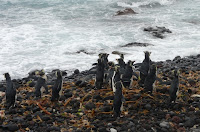 |
| The first treated penguins are released in April 2011. Photo by Katrine Herian/ The RSPB. |
TRISTAN DA CUNHA - Almost a year since thousands of endangered penguins'
lives were threatened by an oil spill on Nightingale Island (part of
Tristan da Cunha, a UK Overseas Territory in the South Atlantic) a
survey to assess the birds' population has taken place.
When the bulk carrier MS Oliva ran aground on 16 March last year, a huge effort to rescue the penguins was launched. The ship was travelling from Brazil to Singapore with a cargo of 65,000 tonnes of soya beans and 1,500 tonnes of bunker fuel when it ran aground.
As the ship broke up in the rough seas, the soya and oil were discharged into the waters around Nightingale. In the days that followed, the oil reached Inaccessible Island, a World Heritage Site, and Tristan more than 30 km away.
With the group of islands being home to over 65 per cent of the global population of endangered northern rockhopper penguins, Tristanians (residents of Tristan da Cunha) and the Tristan Conservation Department, followed by staff from the RSPB and Southern African Foundation for the Conservation of Coastal Birds (SANCCOB), came together and moved quickly to collect and clean up the oiled birds and prevent many more from coming into contact with the oil.
Although efforts to rescue and rehabilitate the penguins were huge, it has been unknown until now just how much the rockhopper population has been affected by the spill. While results from the latest counts suggest the breeding population hasn't suffered as much as anticipated, scientists are warning that the news should be met with caution.
"Though immediate impact is not as bad as we feared, there may be longer term sub-lethal effects reducing breeding success, so it is vital that we continue to monitor the birds closely for several more years to establish the true impact of the oil spill."
Estimations show approximately 154,000 penguins bred on the island in 2011 but estimates in the 1950s suggest there were "millions" of birds, with two million pairs on Gough alone. The species remains globally threatened and the causes of the historic decline remain unknown.
After the disaster, the RSPB launched an emergency appeal to raise funds to help with the clean up. The appeal has raised almost £70,000 and will be used to support penguin monitoring, strengthen the island's biosecurity, and facilitate rodent control on Tristan to reduce risk of rats being introduced to Nightingale.
Katrine Herian works for the RSPB on the island, was involved in the clean-up mission last year, and helped carry out the counts. She said, "Something really needs to be said about the huge Tristanian efforts in response to this disaster - without them, this could have been a very different story.
"While the true impact of the spill won't be known for some time yet, we can at least know that everything that could be done was done."
Read related posts
Source
First assessment of endangered UK penguins since oil spill, 6 February 2012, RSPB press release
No comments:
Post a Comment